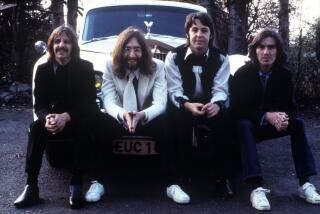How George Martin’s studio tricks and innovations changed pop music
YouTube hosts a vast trove of Beatles outtakes that illustrate the ways in which their longtime producer George Martin, who died Tuesday at age 90, enabled the band to realize even its most outlandish ideas.
Martin was considered by many to be the fifth Beatle for his skills as both a technician and facilitator for the band’s collective muse. But he also revolutionized the recording process. The way he harnessed multitrack tape machines helped turn the studio into an instrument and transformed the process of making a record.
Before Martin’s innovations, the studio’s main role was to accurately capture the sound of musicians at work. Martin made audiotape and the sound recorded on it malleable, flexible — not as much solely the end product but also an ingredient.
One example? The harpsichord solo on the Beatles’ “In My Life” (heard at the 1:29 mark above). Except it’s not a harpsichord at all. Rather, Martin and the band recorded a piano solo at half speed then replayed the sped-up result, which was an octave higher, on the final master.
On “Rain,” Martin introduced to John Lennon the idea of cutting and splicing a section of tape backwards in order to run the guitar lines in reverse. The whole of “A Day in the Life” — including the sampled alarm clock — is a wonder of studio experimentation.
Such experiments had a history. The French composer and acoustician Pierre Schaeffer had long been working with tape loops and found sound, and his inheritors turned it into a movement. Even earlier, Italian futurist artist Luigi Russolo introduced the phrase “the art of noise” while advocating for a new musical aesthetic based on new machines.
Martin and the Beatles, though, helped ferry found and sampled sound into contemporary popular music, where those innovations have resided ever since.
“I think we just grew through those years together, him as the straight man and us as the loonies,” said Ringo Starr in a 1992 documentary about the making of the Beatles’ album-length experimental watershed, “Sgt. Pepper’s Lonely Hearts Club Band.” “But he was always there for us to interpret our strangeness.”
You can hear Martin’s interpretive skills in the studio during an outtake from “Penny Lane.” He sounds like a politely stern taskmaster.
“The role of a producer had changed over the years,” said Martin during the “Sgt. Pepper” documentary, of his work with the Beatles. “When we started in 1962, my job was really an organizer, to get them into some sort of shape and make sure they were tidy in the studio — musically, I mean.”
Starr described Martin at those early sessions as “the big cheese.” “He would come in as the producer, and we were all a little — not afraid, but we knew he was the man. And he was very good. And he was very humorous, so that’s how George really got into our good books. Because we were very tight, the little four of us were really tight together, and very seldom did we let anybody in.”
By the time the band was recording”Sgt. Pepper,” Martin characterized his job as “a realizer of their ideas, so that if John wanted something really weird, I had to try and provide it for him. Or if Paul [McCartney] wanted some extraordinary orchestration, I had to try and find out what he wanted.”
Martin himself demonstrated the creative process in the below clip, which features the producer running through various takes on “Strawberry Fields Forever.” Pay particular attention for the reversed drum track slithering in the background.
The way in which Martin, who sounded every bit the straight-and-narrow English gentleman, translated the psychedelic musings of LSD-addled young geniuses is a lesson in collaboration. Starr noted that disconnect when describing Martin’s studio arrivals.
“We always felt he just got out of his [Triumph] Spitfire and came in, ‘Oh, hello chaps!”
Then they’d get to work.
Follow Randall Roberts on Instagram and Twitter: @liledit
More to Read
The biggest entertainment stories
Get our big stories about Hollywood, film, television, music, arts, culture and more right in your inbox as soon as they publish.
You may occasionally receive promotional content from the Los Angeles Times.











